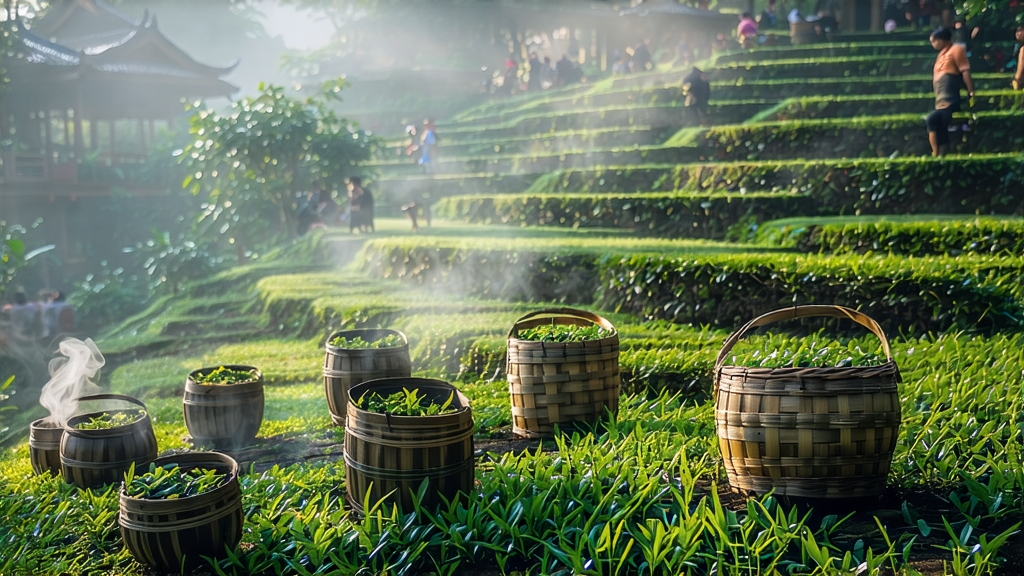
Tucked away in the subtropical hills of southern China, Liu Bao tea has spent four centuries quietly perfecting the art of post-fermentation. Unlike the better-known Pu-erh, Liu Bao is the insider’s black tea—literally “dark tea” in Chinese taxonomy—fermented not in Yunnan’s high plateaus but in the muggy river town of Wuzhou, Guangxi. International drinkers who meet it for the first time often describe the encounter as stumbling upon an aged Bordeaux in a forgotten cellar: earthy yet sweet, musty yet floral, grounding yet mysteriously uplifting.
History: From Border Currency to Maritime Gold
Liu Bao’s story begins during the late Ming dynasty when tea compressed into large bamboo baskets served as barter currency along the Tea-Horse Road. Caravans carried the leaves from Guangxi through Vietnam to Laos and Burma, exchanging them for warhorses and medicinal herbs. The humid journey—weeks on mule-back, nights in misty forests—triggered an accidental microbial fermentation that softened the leaf’s harsh edges and deepened its flavor. By the Qing era, dockworkers in the Pearl River Delta discovered that the same tea, now dark and mellow, eased the damp chill of river life. Demand exploded; junks ferried Liu Bao to Southeast Asia where tin miners in Malaya swore it prevented malaria and “cooled the blood.” In 1801 the Guangdong customs office listed “Wu-zhou dark tea” among the top three exports by volume, alongside silk and porcelain.
Varietals: One Name, Many Faces
Modern Liu Bao is classified by picking standard, leaf age, and aging vessel rather than mountain village like Yunnag teas. The three most common styles encountered abroad are:
- First-grade Spring Tips (Tèjí Liúbǎo): Plucked before Qingming from the small-leaf C. sinensis var. sinensis bushes that carpet the foothills around Liubao township. The finished strip is tight, glossy, and releases a honeyed betel-nut scent after only three years of aging.
- Medium Leaf “Gǔ Zǐ” (Old Grade): Harvested in late April when leaves have grown to the size of a sparrow’s tongue. It carries more stem, ferments faster, and is the workhorse of Malaysian kopitiam teapots, stewed with condensed milk for “cham.”
- Large Basket “Lǎo Chuāng” (Old Boat): Made from mature leaves and even fourth-flush twigs, compressed into 50 kg bamboo baskets that once lined the holds of junks. Fifty-year examples display camphor, nutmeg, and a texture like velvet broth.
Craft: Where Steam, Bacteria, and Time Collude
Liu Bao production follows six classical steps, each calibrated to invite a controlled microbial bloom.
- Pluck & Wilt: Leaves are spread 3 cm deep on bamboo trays for four to six hours, allowing moisture to drop to 68 %. No direct sun—only the warm, fungi-laden breeze of the Xun River valley.
- Kill-Green in Wok: A 260 °C, three-minute toss deactivates leaf enzymes but deliberately avoids complete oxidation; the goal is to preserve microbial substrates.
- Rolling: A 40-minute machine roll ruptures 55 % of cell walls, releasing polyphenols and sugars that will later feed Eurotium cristatum—the prized “golden flower” mold.
- Pile-Fermentation: The signature step. Leaves are heaped 70 cm high inside a steamed room kept at 28 °C and 85 % humidity. Workers turn the pile every five days, sprinkling river water rich in ambient yeasts. Over 25–30 days the leaf color shifts from olive to chestnut, and a faint fungal bloom powders the surface.
- Compression & Basketting: While still warm, the leaf is hand-tamped into double-layered bamboo baskets lined with untreated rice paper. The bamboo’s natural lactobacilli inoculate the tea for decades.
- Warehouse Aging: Baskets are stacked in humid above-ground cellars called “tea caves” where temperatures swing between 20 °C and 30 °C year-round. Unlike Pu-erh’s dry mountain storage, Liu Bao prefers tropical humidity; after ten years the leaf develops a crimson rim and the liquor turns coffee-black.
Brewing: Coaxing the Spirit of the